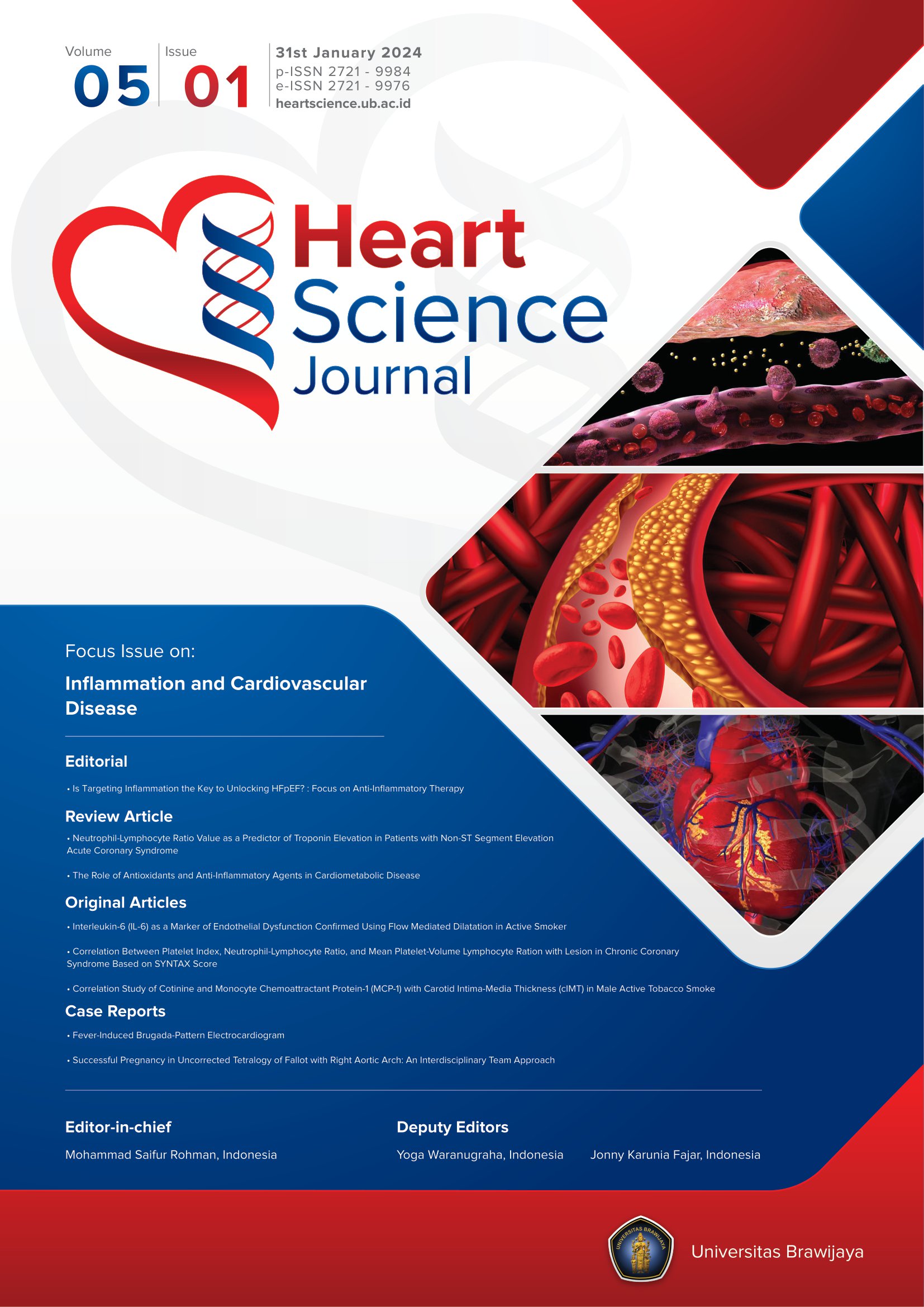Diastolic Dysfunction Following Acute Myocardial Infarction with ST Segment Elevation
Abstract
ST segment elevation myocardial infarction (STEMI) caused by atherosclerotic vulnerable plaque rupture or plaque erosion, resulting in activation of the coagulation cascade. It causes a temporal sequence known as the “ischemic cascade,” which first involves the metabolic process, the diastolic dysfunction, and then systolic dysfunction. Diastolic dysfunction in STEMI patient is an independent predictor for long-term outcome. Rapid and early restoration of blood flow is critical to ensure cell recovery and prevent additional damage.
Keywords
Full Text:
PDFReferences
Heusch G and Gersh BJ. The pathophysiology of acute myocardial infarction and strategies of protection beyond reperfusion: a continual challenge. European heart journal, 2017; 38(11), 774-784.
Damluji AA, van Diepen S, Katz JN, Menon V, Tamis-Holland JE, Bakitas M, et al. Mechanical Complications of Acute Myocardial Infarction: A Scientific Statement From the American Heart Association. Circulation, 2021; 144: e16–e35.
Virani SS, Alonso A, Aparicio HJ, Benjamin EJ, Bittencourt MS, Callaway CW, et al. Heart disease and stroke statistics—2021 update: a report from the American Heart Association. Circulation, 2021; 143(8), e254-e743.
Windecker S, Bax JJ, Myat A, Stone GW, Marber MS. ST-segment Elevation Myocardial Infarction 3 - Future treatment strategies in ST-segment elevation myocardial infarction. Lancet 2013; 382: 644–57.
Vogel B, Claessen BE, Arnold SV, Chan D, Cohen DJ, Giannitsis E, Mehran R, et al. ST-segment elevation myocardial infarction. Nature Reviews Disease Primers, 2019; 5(1), 1-20.
Badimon, L. Pathogenesis of ST-Elevation Myocardial Infarction. In Coronary Microvascular Obstruction in Acute Myocardial Infarction. Elsevier, 2018; pp. 1-13.
Toutouzas K, Kaitozis O, and Tousoulis D. Primary percutaneous coronary intervention. Coronary Artery Disease: From Biology to Clinical Practice, 2017; 417-437.
Libby P and Pasterkamp G. Requiem for the ‘vulnerable plaque’. European Heart Journal, 2015; 36, 2984–2987.
Widimsky P, Crea F, Binder RK, and Lu¨scher TF. The year in cardiology 2018: acute coronary syndromes. European Heart Journal, 2019; 40, 271–283.
Ahmed N. Myocardial Ischemia. In: Pathophysiology of Ischemia Reperfusion Injury and Use of Fingolimod in Cardioprotection. Academic Press, 2019; 41-56.
Yilmaz A, Angina pectoris in patients with normal coronary angiograms: Current pathophysiological concepts and therapeutic options. Heart 2012; 98: 1020-1029.
Ramachandra CJ, Hernandez-Resendiz S, Crespo-Avilan GE, Lin YH, and Hausenloy DJ. Mitochondria in acute myocardial infarction and cardioprotection. EBioMedicine, 2020; 57, 102884.
Wang R, Wang M, He S, Sun G, and Sun X. Targeting calcium homeostasis in myocardial ischemia/reperfusion injury: an overview of regulatory mechanisms and therapeutic reagents. Frontiers in Pharmacology, 2020; 11, 872.
Prabhu SD and Frangogiannis NG. The Biological Basis for Cardiac Repair After Myocardial Infarction From Inflammation to Fibrosis. Circulation Research, 2016;119: 91-112.
Curaj A, et al. Neutrophils Modulate Fibroblast Function and Promote Healing and Scar Formation after Murine Myocardial Infarction. International Journal of Molecular Science. 2020, 21, 3685.
Liehn EA, Postea O, Curaj A, and Marx N. Repair After Myocardial Infarction, Between Fantasy and Reality The Role of Chemokines. Journal of the American College of Cardiology, 2011; Vol. 58, No. 23.
Richardson WJ, Clarke SA, Quinn TA, and Holmes JW. Physiological Implications of Myocardial Scar Structure. Compr Physiol. 2016; 5(4): 1877–1909.
González A, Schelbert E, Díez J, and Butler J. Myocardial Interstitial Fibrosis in Heart Failure. Journal of American College of Cardiology, 2018; Vol 71, no.15.
Fox KAA. Management Principles in Myocardial Infarction. In Myocardial Infarction: A Companion to Braunwald's Heart Disease E-Book, 2016; p.139-152.
Berezin AE and Berezin AA. Adverse Cardiac Remodelling after Acute Myocardial Infarction: Old and New Biomarkers. Hindawi, 2020; 1215802, 21 pages.
Baron T, Christersson C, Hjorthen G, Hedin EM, Flachskampf FA. Changes in global longitudinal strain and left ventricular ejection fraction during the first year after myocardial infarction: results from a large consecutive cohort. Eur Heart J Cardiovasc Imaging. 2018;19(10):1165–73.
Mackiewicz U, Kołodziejczyk J, and Lewartowski B. Cellular mechanisms of diastolic dysfunction in the heart failure. Postępy Nauk Medycznych, 2014; XXVII, nr 7.
Nagueh SF. Left ventricular diastolic function: understanding pathophysiology, diagnosis, and prognosis with echocardiography. JACC: Cardiovascular Imaging, 2020; 13(1 Part 2), 228-244.
Parajuli N, Ramprasath T, Zhabyeyev P, Patel VB, and Oudit GY. The Role of Neurohumoral Activation in Cardiac Fibrosis and Heart Failure. In: Cardiac Fibrosis and Heart Failure—Cause or Effect? Springer, 2015; p.347-404.
Planer D, Mehran R, Witzenbichler B, Guagliumi G, Peruga JZ, Brodie BR, et al. Prognostic utility of left ventricular end‑diastolic pressure in patients with ST‑segment elevation myocardial infarction undergoing primary percutaneous coronary intervention. Am J Cardiol. 2011;108:1068–74.
Yajima K, Ikehara N, Yamase Y, Kondo T, and Ohte N. Left Ventricular Diastolic Dysfunction in Patients with ST-elevation Myocardial Infarction: 10 Years Follow-Up. Journal of the American College of Cardiology, 2019; Vol. 73, Issue 9.
Khan AA, Al‑Omary MS, Collins NJ, Attia J, and Boyle AJ. Natural history and Prognostic Implications of Left Ventricular End-Diastolic Pressure in Reperfused ST-segment Elevation Myocardial Infarction: an Analysis of the Thrombolysis in Myocardial Infarction (TIMI) II Randomized Controlled Trial. BMC Cardiovascular Disorders, 2021; 21:243.
DOI: https://doi.org/10.21776/ub.hsj.2022.003.02.2
Refbacks
- There are currently no refbacks.
Copyright (c) 2022 Imelda Krisnasari

This work is licensed under a Creative Commons Attribution 4.0 International License.









